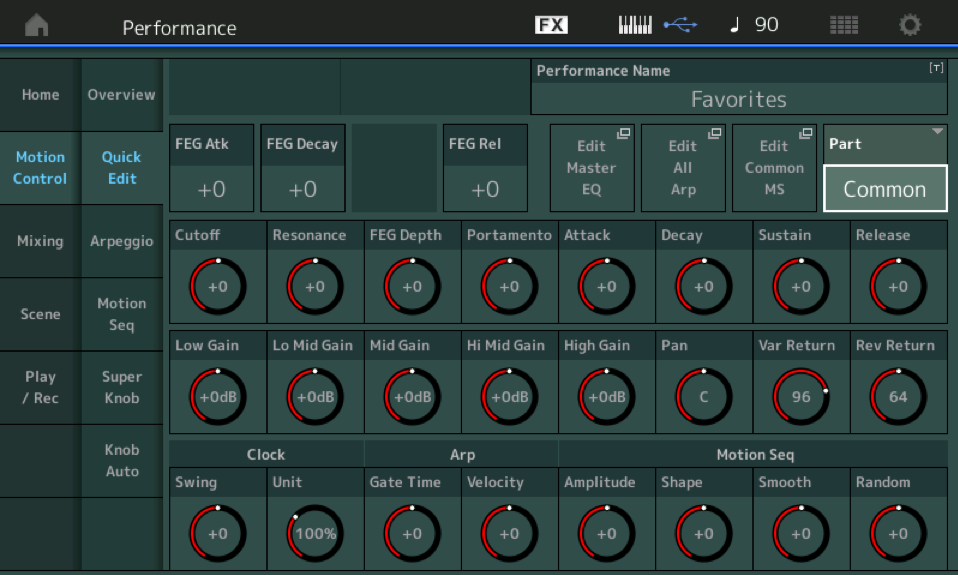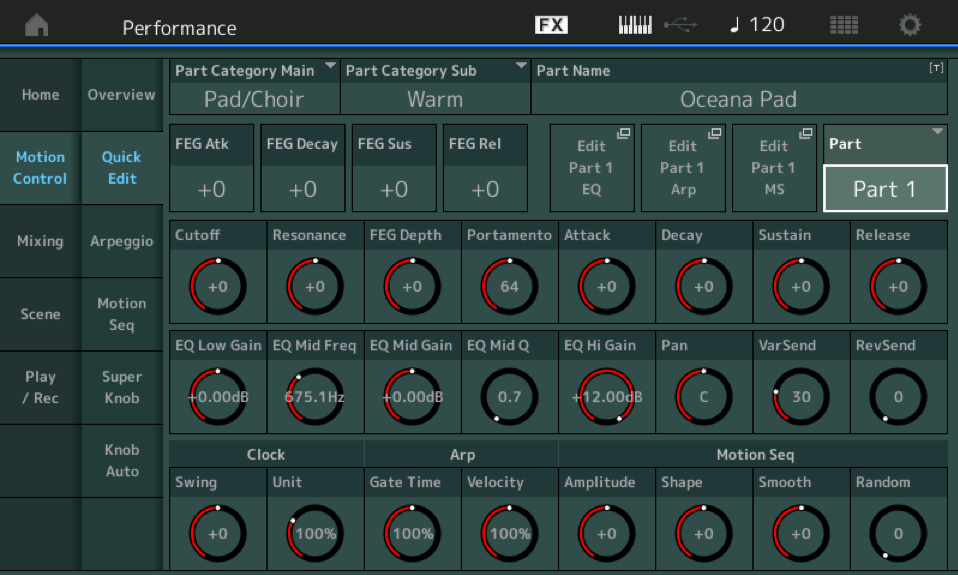Simple Answers appreciated 😉
In the Quick Edit Screen (and also the Top Panel "Assign" knobs if selected), you have instant choices of Attack, Decay and Release.
There's also an FEG Depth parameter box.
My ears tell me the that the default Attack, Decay and Release controls are controlling an Amp Envelope.
Is this Envelope an overarching "Hidden Envelope" (No graphic representation) that governs the sound as a Whole (All Parts).
Or, is it just "Offsetting" whatever Amp Envelopes may have been set for Elements or Operators?
I thought it was the former, then today I noticed you can change the Quick Edit layout from "Common" (Performance) by choosing Part 1, Part 2 etc. in which case you get full FEG and (unspecified, so presumed) AEG controls.
Are these all just "Offset Controllers"?
[quotePost id=119371]
Are these all just "Offset Controllers"?
[/quotePost]
I think so. I think of them more as "scalars" or "multipliers", but yes... I'm pretty sure this is what they are. I've used them all of about twice... sorry... am kind of bumping in the hope someone can give a more exact answer...
Simple answer: these are offsets and all but Sustain are time. Sustain is the level.
Documentation based longer answer ...
Just so you know what parameters these are offsetting (from the Reference Manual) ...
• Attack (AEG Attack Time)
• Decay (AEG Decay Time)
• Sustain (AEG Sustain Level)
• Release (AEG Release Time)
And then the reference manual mentions something about the mechanism:
Attack (AEG Attack Time)
Determines the speed of attack from the time a key is played until the maximum initial level of the AEG
is reached. This parameter determines the offset value of the AEG (page 110, page 129, page 143) for
the Element/Drum Key/Operator.
Settings: -64 – +63Decay (AEG Decay Time)
Determines how fast the volume falls from maximum attack level to the sustain level. This parameter
determines the offset value of the AEG (page 110, page 129, page 143). for the Element/Drum Key/
Operator
Settings: -64 – +63Sustain (AEG Sustain Level)
Determines the sustain level at which the volume will continue while a note is held, after the initial attack
and decay. This parameter determines the offset value of the AEG (page 110, page 129, page 143) for
the Element/Drum Key/Operator.
Settings: -64 – +63Release (AEG Release Time)
Determines how fast the volume falls from the sustain level to zero when a note is released. This
parameter determines the offset value of the AEG (page 110, page 129, page 143) for the Element/
Drum Key/Operator.
Settings: -64 – +63
You see how these are designated as "offsets" and the values are relative "-64" through "+63" (not absolute values).
OK... I think we ascertained that the Common and Part Quick Edits are just preformatted Macro's for offsetting actual parameter values.
Thanks everyone 😉
[quotePost id=119385]I did some testing for depth to see what I could find
1. INIT NORMAL (AWM2)
2. Edit - Part 1 - Element 1
3. go to Filter -> Filter EG
4. set FEG Depth to -20 so sound is soft and weak
5. go to performance home
6. Motion Control -> Quick Edit
7. FEG DEPTH (1st row - 3rd) default is 0 for COMMON
8. Dial value higher and the sound will get louder and louder
9. Leave the value at 40 and return to the Filter -> Filter EG screen
10. FEG Depth is still at -20 where you left it
11. Dial value around even to max 63
12. Sound does NOT change in level
Conclusion: FEG Depth is an OVERRIDE. It is was just an offset then the sound should vary as you change the depth setting at the element level.
But that appears to be the WRONG conclusion - I started intentionally with performance common versus element changes expecting the above.
[/quotePost]
This only proves the pinning (as Antony calls it, but that you and I might refer to as the combined influence of scalar/offset and original value having hit a ceiling), not that it's overriding.
Pull back your amount of Common Control, and/or find ways to also experiment with less depth, not only more, and it becomes apparent that it's not an override.
I might have been guilty of taking the piss out of how programmers often attempt to teach by showing the wrong ways/things and syntax errors first. I can't stand this approach and think it holds back the world.
The “Quick Edit” Knobs allow exactly what they say they indicate. If you have a KBD CTRL Performance containing 64 Elements (8 in each Part) — you realize that each Element has its own completely programmable AEG.
Now say you are performing and you wish to simply slow the Attack for the Bridge section of the song, wouldn’t you look silly trying to access 64 different individual Attack parameters, one-by-one, in the second and a half you have to make the changes?
Wouldn’t it be wise, like Sauron, to create one ring (er, knob) to rule them all…. To rule the Attack of all 64 Element’s Attack together? The Quick Edit Knob functions (you have both COMMON - means all Parts:

and you have PART - means all Elements of the selected Part) can be quickly edited, together:

It does so by Offsetting the currently stored value of each Element’s own AEG Attack!
Same goes for all the so-called Quick Edit Knob area functions… 64 Elements would mean 64 Filters, 64 FEG Depth controls, potentially 64 Cutoff Frequencies etc., etc., etc. Don’t over think it. Quick Edit means the ability to Edit all components quickly, especially those that have intricate individual controls, as a group. Say Element 1, 2, 3 and 4 feature HPFs, and Elements 5, 6, 7, and 8 feature LPF, BPF, and a couple of BEFs, respectively, the Quick Edit Cutoff Knob will change (offset) the Filter Cutoff frequency of each from its current setting, regardless of its type.
Please note: with Cutoff, Resonance and FEG, for example, if no Filter is assigned to the Element within a Part (Filter = Thru), naturally there will be no Filter Cutoff or Resonance or Depth to offset with the Quick Edit Filter Knobs … so the Cutoff, Resonance, and the FEG Knobs do not represent a Filter themselves, they only offset an existing Part’s Filter if it has one assigned! It sounds obvious but many believe it represents a specific Filter - it does not. It represents many… but only if they exist within the Elements.
